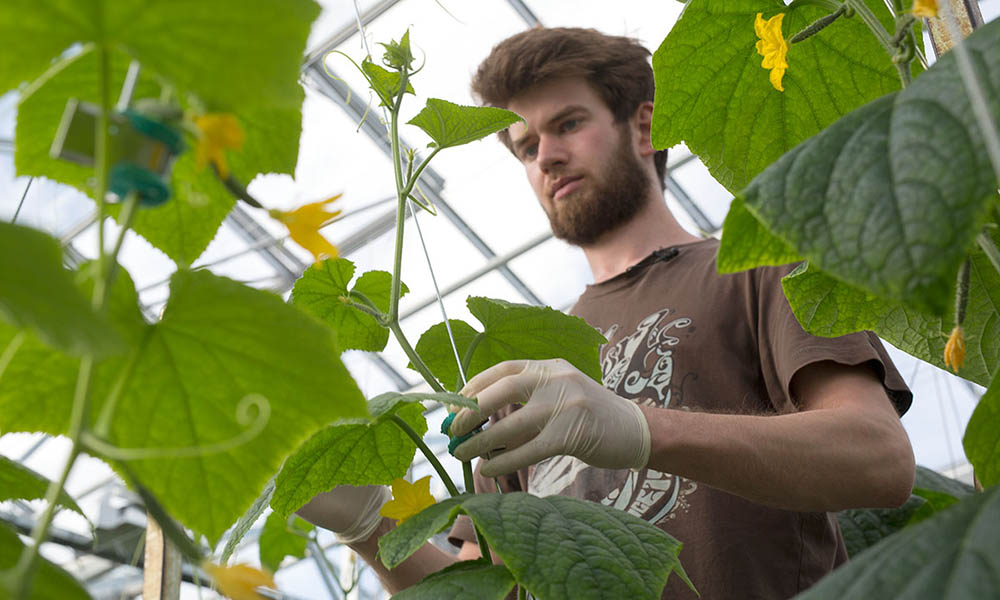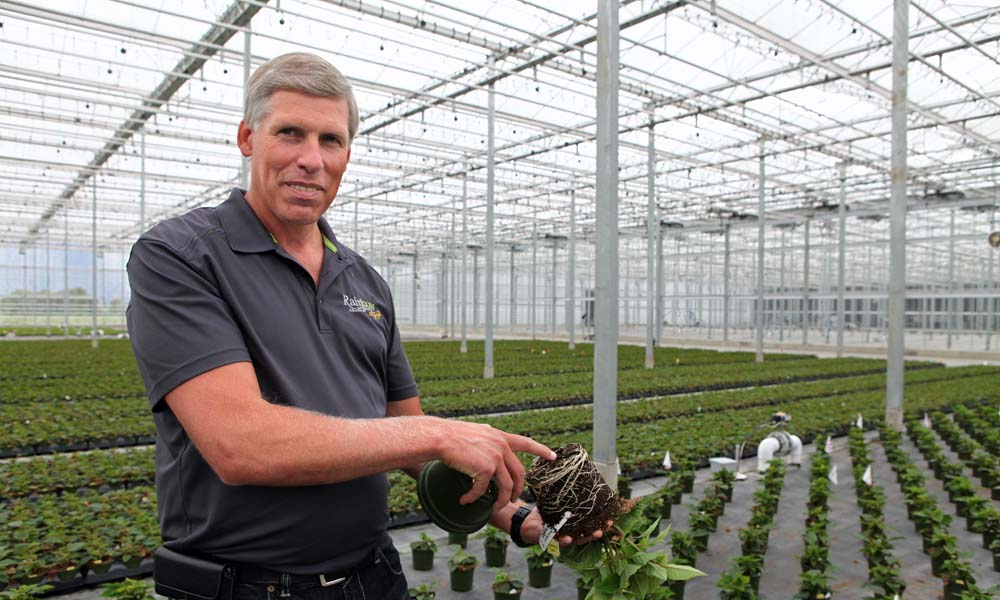Xclusive Uganda – a company with Dutch roots − specialises in producing cuttings of chrysanthemum, kalanchoe and garden and pot plants. It supplies various Dutch customers, the largest of which are also co-shareholders in the company. Besides supplying top quality cuttings material, the directors are committed to giving something back to the country and to their employees. They therefore have additional facilities including an on-site clinic and crèche.
The foundation for the Xclusive Uganda of today was laid in 2004 by Dutchman Peter Benders. He had worked for the Dutch breeder Royal Van Zanten in Uganda for many years, but after going back to the Netherlands he was unable to settle and wanted to return to the African country.
“It was where his heart was,” says co-shareholder Hans van Eijzeren. “So he started his own business here, specialising in producing cuttings material for Dutch companies. To put the business on a stronger footing, he also actively sought out customers who wanted to buy cuttings from him and would also take a stake in the business. At that time, transferring cuttings production to Africa was a real trend. In countries like Uganda, labour costs are a lot lower and, unlike in the Netherlands, there is a good supply of labour.”
More than 200 million cuttings per year
This eventually resulted in a collaboration on producing kalanchoe cuttings with Dutch companies KP Holland and SV.CO. Two years later, the breeder Floritec, for which the company started producing chrysanthemum cuttings, also became a shareholder. In addition, former kalanchoe grower Van Eijzeren and some members of Peter Benders’ family took stakes in the company. “From that point on, our focus was on producing chrysanthemum and kalanchoe cuttings and cuttings material from various arboricultural species as well as garden and hanging plants,” says Van Eijzeren. “It started small, but over the years the company has undergone considerable growth. We now produce 100 million chrysanthemum cuttings, 65 million kalanchoe cuttings and 50 million cuttings of arboricultural products and garden and hanging plants per year.”
Excellent climate
The cuttings nursery is situated near the Ugandan town of Gayaza in the south of the country, about 50 kilometres north of the capital Kampala. “It is a perfect location for cuttings production,” says managing director Sjoerd de Boer, who runs the company’s day-to-day operations together with Van Eijzeren. “The climate here is excellent: the light intensity is high, there is enough rainfall throughout the year and the daytime temperature is around 25 to 28°C, falling to 18 to 19°C at night. So it is an extremely benign growing climate that encourages good vegetative growth. And that is exactly what you need for cuttings production. It enables us to produce better quality cuttings material for most of the year than we could in the Netherlands. You simply need too much energy to achieve the ideal climate in the Netherlands – plus there is almost no labour available in Western Europe.”
Variety, length and weight requirements
Cuttings production takes place in 10.5 ha of plastic sawtooth greenhouses, where the stock plants grow on mobile benches. They are grown in a mixture of pumice and coir. “The greenhouses are equipped with modern technology,” says Van Eijzeren. “For example, they have drip irrigation and in some cases even a misting system. We also have screens over the greenhouses to screen out excess sunlight at certain times.”
According to De Boer, the biggest challenge is cutting the shoots of the stock plants – the cuttings – at the right time and to the right specifications. “We have strict agreements with our customers on supplying specific quantities of cuttings at certain times and to certain specifications: variety, length, weight, and so on. It is always a bit of a puzzle to get this right each time. The newly cut cuttings go into the cold store, after which they are taken to the airport in refrigerated trucks to be flown to the Netherlands.”
IPM
As far as crop protection is concerned, the company applies the same regime as Dutch companies, as that is what their customers and end customers want. In concrete terms, this means that they avoid the use of chemicals wherever possible and use Integrated Pest Management as standard. “We use fungal preparations, natural predators and green products to keep pests and diseases under control,” says van Eijzeren.
Irrigation is done with rainwater, which is collected in a marshy field with a filtering effect and pumped from there into a reservoir. “However, we get quite a lot of water loss this way. So we are currently in discussions with the Ugandan government to get permission to excavate larger reservoirs. Then we can make optimum use of the rainwater that falls.”
On-site clinic
The company has around 500 Ugandan employees. “As mentioned, availability of labour is not an issue here: there are very few jobs in the area and people are always available,” Van Eijzeren says. “And they are also keen to work. Although the work mentality is different from in Western Europe, we have worked out a way around that.”
From the outset, the directors not only wanted to produce high-quality cuttings in Uganda and build a profitable business; they also wanted to make a contribution to the country and its people and give something back to them, he points out. “This was also an important intrinsic motivation for Peter and me; we ran the company together for years. Through the nursery, we offer five hundred people work and therefore many families an income. But we wanted to do more. Because people in this region have almost no access to medical facilities, we set up a first aid station at the nursery very early on. That has now grown into a proper clinic, where we offer outpatient care.”
In addition, employees are given breakfast and lunch at the company every day. There is a crèche and employees can plant their own allotments on vacant land owned by the company. Around 100 people are already making use of this. “As I said, it’s not just about profitability but also about making a difference for our people. We want to give them a better life. And I would go so far as to say that we have already achieved quite a lot in this area. What’s more, investing in employees gives you a licence to produce; after all, without people, you can’t make it as a company.”
Death of Peter Benders
But the company has also gone through some difficult times. The COVID pandemic was a tough period, of course, partly because exporting to the Netherlands was difficult in those years. But the sudden death of founder Peter Benders in April last year was a particularly severe blow. Van Eijzeren: “Everyone was in shock. And for a while our staff were worried that they would lose their jobs, as in their minds Peter was the sole shareholder.
“Fortunately, we were soon able to allay their concerns and we also managed to ensure that the company could continue to operate normally. Partly by appointing Sjoerd de Boer, who had been working at Xclusive Uganda for two years at the time, as managing director. The fact that we had a good management team in place also made a big difference. Nevertheless, 2022 was a hectic year, but now calm has returned.”
Growth ambitions
The big question is: what plans does the company have for the future? The two are in no doubt: they hope the company will grow even further in the coming years. “And we have the space to do that, too: we can add a good number of hectares still,” De Boer says. “Also, we still see room in the market, with our partners. But we are also very much open to new partners. And we are looking at expanding our product range, seeing what other products we might be able to add that can be propagated via cuttings.”
One big family
The directors emphasise that they are proud of where the company is today. Van Eijzeren: “What started out based on Peter’s passion for Uganda has grown into a thriving business. It’s a company to be proud of. Hence our slogan, ‘Proud to be Xclusive’. Besides, it is just so great to be working in Africa; I love it. The Ugandans are wonderful people to work with and they really appreciate what do for them. That feels good; in fact, we are one big family.”
Text and images: Ank van Lier
















